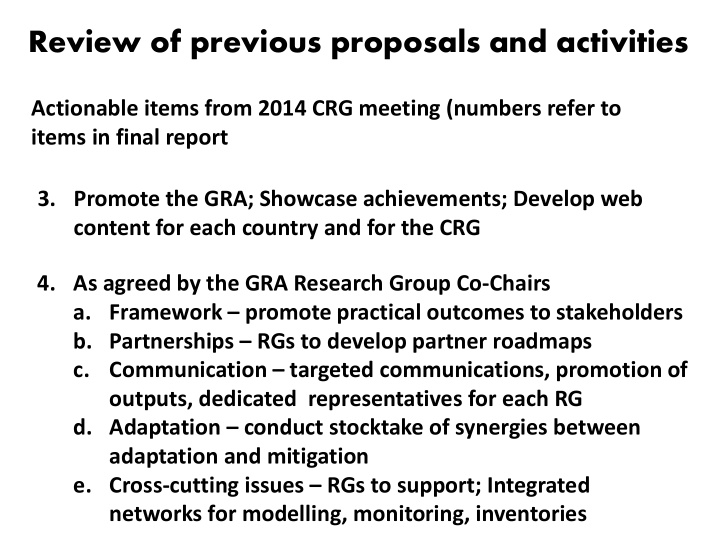



Review of previous proposals and activities Actionable items from 2014 CRG meeting (numbers refer to items in final report 3. Promote the GRA; Showcase achievements; Develop web content for each country and for the CRG 4. As agreed by the GRA Research Group Co-Chairs a. Framework – promote practical outcomes to stakeholders b. Partnerships – RGs to develop partner roadmaps c. Communication – targeted communications, promotion of outputs, dedicated representatives for each RG d. Adaptation – conduct stocktake of synergies between adaptation and mitigation e. Cross-cutting issues – RGs to support; Integrated networks for modelling, monitoring, inventories
8. Members to provide input for MAGGnet 11. N2O modeling workshop (Paris 2014) papers and next steps with the Soil CN CC Group – see CRG website for materials 14. GRAMP member registration and participation in monthly webinars 19. Develop research site network of peatlands 22. CRG GHG mitigation options summary / report 27. GRA side event at CABI triennial meeting in 2016 28. Information dissemination and databases with CABI 30. Monthly webinars – initial contributions from CCAFS, Soil CN CC Group
32. Fact sheets / decision support tools to farmers and options for communication strategies 34. Soil CN modeling (see Item 11); MAGGnet (see Item 8); synthesis of GHG mitigation options (see Item 22) 36. Evaluation of chamber vs eddy covariance techniques 37. Tree crops (olives, vineyards) network 38. Spanish ‘ Remedia ’ network expansion 39. Characterizing hotspots of GHG emissions around the world; Yield gap analysis 42. Identify key mitigation options for testing by Soil CN CC Group
43. Solicit expert opinion and examples of modeling for tree crops and crop rotations 45. Filling gaps in measurement and monitoring of soil carbon in grasslands and diversified landscapes 47. Further develop relationship with CCAFS 48. Explore GRA-wide proposals to World Bank 49. Develop ideas for additional World Bank proposals on insurance / risk, GHG emissions with crop failure, relationships to food security 51. Characterizing synergies between mitigation and adaptation
CRG Action Plan developed in 2011 – Anticipated Products Component 1: Quantifying net GHG emissions in cropland management systems o Standardized / acceptable protocols and improved methods for determining soil C sequestration and GHG emissions o International database of existing and new research on GHG emissions and soil C sequestration rates as affected by particular agricultural management systems o Synthesis of available experimental results around the world o Guidelines / BMPs for minimizing GHG emissions and maximizing soil C sequestration under various climatic conditions, ecoregional delineations, and/or soil types o Summary documents for use by international negotiating bodies concerned with GHG emissions, soil stewardship, and natural resource management
CRG Action Plan developed in 2011 – Anticipated Products Component 2: Assessing GHG emissions in agricultural peatlands and wetlands o Overview reports of ongoing research / status of peatlands related to GHG emissions o Publications / reports on recommended BMPs and their impacts on reducing GHG emissions o Compilation of GHG emission datasets that will contribute to database development (Comp 1) and modeling of C/N (Comp 3) o Recommendations for improved technologies / BMPs to restore peatlands to more naturally occurring ecosystem functioning o Data made available to cross-cutting group on inventories and measurement methods, through knowledge transfer, datasets, discussion notes for methods, overview of existing methods, and contributions at seminars or other discussions forums
CRG Action Plan developed in 2011 – Anticipated Products Component 3: Modeling C and N emissions o Review articles and list of publications using (a) N 2 O emission and (b) soil organic C models o Bibliometric analysis of the global literature on N 2 O and SOC and a map of the main research groups active on these topics o Evaluation of models of direct N 2 O emissions according to: o spatial scale (e.g. laboratory, field, landscape, regional, etc.) o time scale o input data requirement o main simulated processes o context and range of situations tested o purposes for which they are suitable (e.g. hypothesis testing, decision support system, regional inventories, etc.) o main related publications
CRG Action Plan developed in 2011 – Anticipated Products Component 3: Modeling C and N emissions o Evaluation of models of soil C dynamic (with information similar to that described for modeling of N 2 O emissions above) o Short list of recommended models that have been widely used and tested in a wide range of situations for a particular set of conditions and purposes o List of models that use a mass balance approach in considering the cycling of both C and N within the same model framework
Recommend
More recommend